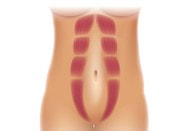|
By Dr. Katie Casto, PT, DPT, PCES  Diastasis Rectus Abdominis (DRA) refers to the separation of the two muscle bellies of the rectus abdominis - our “6 pack” muscle. The separation occurs at the linea alba: the connective tissue that runs vertically down the middle of the muscle (separates the two sides of the “6 pack”) that can become thinned or stretched out. This separation or “gap” can occur at the navel, above the navel or below the navel. How to know if you truly have a diastasis? Keep reading! How do I know If I have a diastasis? See your PT! There are therapists specialized in assessing and treating DRA so look for someone who also does pelvic floor therapy or focuses on assisting in postpartum recovery. Diastasis is assessed while lying on the back with knees bent and feet flat. Your physical therapist will measure the distance between the two muscle bellies above the navel, at the navel and below the navel as the head is lifted. A distance greater than 2 finger widths is considered a diastasis. Your physical therapist will also measure the depth of the diastasis by assessing how many knuckles deep the fingers sink into the separation. Many argue the depth of the diastasis is much more important functionally than the width of the separation. How common is this? DRA is extremely common in pregnant women, although it can occur in both women AND men. Research has estimated that nearly 100% of pregnant women at the end of their 3rd trimester have a DRA. However, in most cases the width of the diastasis decreases through natural healing after birth, with ~40% of postpartum with persistent DRA 6 months after giving birth. (Michalska et al., 2018). DRA has been associated with pregnancy, c-section, genetic collagen abnormalities, and history of abdominal surgery. Interestingly, the baby’s size and weight, mom’s BMI and weight gain during pregnancy, regular exercise and heavy lifting have not been shown to be risk factors for diastasis (Michalska et al., 2018). Why does it matter if I have a diastasis? Presence of DRA can signify poor loading through the core musculature and lead to issues including:
If you are struggling with a persistent DRA, see a physical therapist that specializes in pelvic floor health or postpartum recovery! We can help assess why the “gap” may not be closing, and help develop a treatment plan that is individualized to your needs and goals. A couple of things your physical therapist will look at during your appointment: Core Activation Patterns
Breathing
Posture
There are many other factors that may be contributing to a persistent diastasis in addition to the ones listed above. Reach out to us today to schedule an appointment for an individual assessment with one of our Postpartum Corrective Exercise Specialist Certified Pelvic Floor Physical Therapists to help you get back on track! There are a variety of ways we can help including 1:1 in-person sessions, an online program you can do by yourself in the comfort of your home, or postpartum-safe personal training. References:
Thabet AA, Alshehri MA. Efficacy of deep core stability exercise program in postpartum women with diastasis recti abdominis: a randomised controlled trial. J Musculoskelet Neuronal Interact. 2019 Mar 1;19(1):62-68. PMID: 30839304; PMCID: PMC6454249. Michalska A, Rokita W, Wolder D, Pogorzelska J, Kaczmarczyk K. Diastasis recti abdominis - a review of treatment methods. Ginekol Pol. 2018;89(2):97-101. doi: 10.5603/GP.a2018.0016. PMID: 29512814. Duvall, Sarah. “Postpartum Corrective Exercise Specialist” Course. Core Exercise Solutions (2020).
0 Comments
Your comment will be posted after it is approved.
Leave a Reply. |
Meet Your TherapistJessica has been in Austin, TX for the past four years. She grew up in Idaho and attended PT school at Idaho State University. She completed an Orthopaedic Residency and became a Board Certified Orthopaedic Clinical Specialist in 2016. Archives
February 2022
Categories
All
|

 RSS Feed
RSS Feed